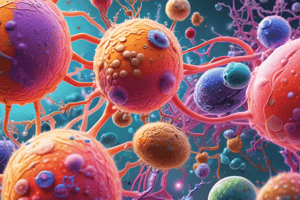Podcast
Questions and Answers
Which of the following components is NOT part of the body's primary defenses against infection?
Which of the following components is NOT part of the body's primary defenses against infection?
- Respiratory tract
- Gastrointestinal tract
- Phagocytosis (correct)
- Skin
Which of the following processes is a key component of the body's secondary defenses against infection?
Which of the following processes is a key component of the body's secondary defenses against infection?
- Active immunity
- Antibodies
- Skin barrier
- Fever (correct)
What best describes the role of antibodies in the immune response?
What best describes the role of antibodies in the immune response?
- They directly kill pathogens.
- They serve as long-term memory of infections.
- They are exclusively involved in primary defenses.
- They can neutralize or mark pathogens for destruction. (correct)
Which type of immunity is gained by direct exposure to an antigen and subsequent recovery?
Which type of immunity is gained by direct exposure to an antigen and subsequent recovery?
Which of the following statements accurately describes artificially acquired passive immunity?
Which of the following statements accurately describes artificially acquired passive immunity?
What characterizes tertiary defenses in the immune system?
What characterizes tertiary defenses in the immune system?
What defines naturally acquired passive immunity?
What defines naturally acquired passive immunity?
Which of the following immune responses helps prevent infections through barriers?
Which of the following immune responses helps prevent infections through barriers?
Which type of immunity is primarily developed through vaccinations?
Which type of immunity is primarily developed through vaccinations?
Which immune response involves the activation of phagocytes following pathogen detection?
Which immune response involves the activation of phagocytes following pathogen detection?
Which factor does NOT increase the risk of developing infections?
Which factor does NOT increase the risk of developing infections?
What is NOT a characteristic of the prodromal stage of infection?
What is NOT a characteristic of the prodromal stage of infection?
Which of the following is a common sign of a localized infection?
Which of the following is a common sign of a localized infection?
What is a distinguishing feature of secondary infections?
What is a distinguishing feature of secondary infections?
When comparing acute and chronic infections, which statement is true?
When comparing acute and chronic infections, which statement is true?
What differentiates endogenous infections from exogenous infections?
What differentiates endogenous infections from exogenous infections?
Which stage of infection is expressed by clear signs and symptoms, potentially leading to recovery or death?
Which stage of infection is expressed by clear signs and symptoms, potentially leading to recovery or death?
Which statement about the chain of infection is correct?
Which statement about the chain of infection is correct?
How does tobacco use primarily affect susceptibility to infections?
How does tobacco use primarily affect susceptibility to infections?
Which of the following correctly identifies the factors contributing to systemic infections?
Which of the following correctly identifies the factors contributing to systemic infections?
What is not a characteristic of a reservoir in the chain of infection?
What is not a characteristic of a reservoir in the chain of infection?
Which practice is incorrectly associated with medical asepsis?
Which practice is incorrectly associated with medical asepsis?
Which of the following statements about hand hygiene is false?
Which of the following statements about hand hygiene is false?
What incorrectly describes the guidelines for hand hygiene in surgical settings?
What incorrectly describes the guidelines for hand hygiene in surgical settings?
What is an incorrect understanding of standard precautions?
What is an incorrect understanding of standard precautions?
Which statement about transport-based precautions is inaccurate?
Which statement about transport-based precautions is inaccurate?
What is the primary purpose of clean technique in medical settings?
What is the primary purpose of clean technique in medical settings?
What is not a requirement for PPE when dealing with droplets?
What is not a requirement for PPE when dealing with droplets?
Which of the following practices are indicative of surgical asepsis?
Which of the following practices are indicative of surgical asepsis?
Which is incorrectly associated with airborne precautions?
Which is incorrectly associated with airborne precautions?
What is a misleading comparison between standard and transmission-based precautions?
What is a misleading comparison between standard and transmission-based precautions?
When is sterility considered compromised in a clinical setting?
When is sterility considered compromised in a clinical setting?
What distinguishes surgical asepsis from medical asepsis?
What distinguishes surgical asepsis from medical asepsis?
Which factor is not a role of maintaining a clean environment in infection prevention?
Which factor is not a role of maintaining a clean environment in infection prevention?
Which level of asepsis focuses on maintaining a sterile environment during surgical procedures?
Which level of asepsis focuses on maintaining a sterile environment during surgical procedures?
What is a key characteristic of the methods employed in medical asepsis?
What is a key characteristic of the methods employed in medical asepsis?
Which scenario indicates a proper practice of surgical asepsis?
Which scenario indicates a proper practice of surgical asepsis?
What should a nurse do if sterility is compromised during a procedure?
What should a nurse do if sterility is compromised during a procedure?
In which situation would transmission-based precautions be necessary?
In which situation would transmission-based precautions be necessary?
What defines the role of a nurse concerning emerging infectious diseases?
What defines the role of a nurse concerning emerging infectious diseases?
Flashcards
Primary Defenses
Primary Defenses
The body's initial line of defense against infection, preventing pathogens from entering the body. Examples include skin, respiratory tract, eyes, mouth, gastrointestinal tract, and genitourinary tract.
Secondary Defenses
Secondary Defenses
The body's internal defense system that acts rapidly to fight off infection when pathogens get past the primary defenses. Examples include phagocytosis, complement cascade, inflammation, and fever.
Tertiary Defenses
Tertiary Defenses
The body's long-term, specific defense system that targets and eliminates specific pathogens. Examples include active and passive immunity.
Naturally Acquired Active Immunity
Naturally Acquired Active Immunity
Signup and view all the flashcards
Naturally Acquired Passive Immunity
Naturally Acquired Passive Immunity
Signup and view all the flashcards
Artificially Acquired Active Immunity
Artificially Acquired Active Immunity
Signup and view all the flashcards
Artificially Acquired Passive Immunity
Artificially Acquired Passive Immunity
Signup and view all the flashcards
Antigen
Antigen
Signup and view all the flashcards
Antibody
Antibody
Signup and view all the flashcards
Pathogen
Pathogen
Signup and view all the flashcards
What increases infection risk?
What increases infection risk?
Signup and view all the flashcards
How does tobacco use increase infection risk?
How does tobacco use increase infection risk?
Signup and view all the flashcards
How do chronic diseases increase infection risk?
How do chronic diseases increase infection risk?
Signup and view all the flashcards
What are the five stages of infection?
What are the five stages of infection?
Signup and view all the flashcards
What happens during the incubation stage?
What happens during the incubation stage?
Signup and view all the flashcards
Reservoir in the Chain of Infection
Reservoir in the Chain of Infection
Signup and view all the flashcards
Medical Asepsis
Medical Asepsis
Signup and view all the flashcards
What happens during the prodromal stage?
What happens during the prodromal stage?
Signup and view all the flashcards
What are the signs of a localized infection?
What are the signs of a localized infection?
Signup and view all the flashcards
Hand Hygiene
Hand Hygiene
Signup and view all the flashcards
Hand Hygiene Guidelines (Nonsurgical Setting)
Hand Hygiene Guidelines (Nonsurgical Setting)
Signup and view all the flashcards
What are the signs of a systemic infection?
What are the signs of a systemic infection?
Signup and view all the flashcards
Hand Hygiene Guidelines (Surgical Setting)
Hand Hygiene Guidelines (Surgical Setting)
Signup and view all the flashcards
Local vs. Systemic infection
Local vs. Systemic infection
Signup and view all the flashcards
Primary vs. Secondary infection
Primary vs. Secondary infection
Signup and view all the flashcards
Standard Precautions
Standard Precautions
Signup and view all the flashcards
Transmission-Based Precautions
Transmission-Based Precautions
Signup and view all the flashcards
Personal Protective Equipment (PPE)
Personal Protective Equipment (PPE)
Signup and view all the flashcards
Contact Precautions
Contact Precautions
Signup and view all the flashcards
Droplet Precautions
Droplet Precautions
Signup and view all the flashcards
Clean technique (medical asepsis)
Clean technique (medical asepsis)
Signup and view all the flashcards
Sterile technique (surgical asepsis)
Sterile technique (surgical asepsis)
Signup and view all the flashcards
Methods of medical asepsis
Methods of medical asepsis
Signup and view all the flashcards
Methods of surgical asepsis
Methods of surgical asepsis
Signup and view all the flashcards
Breach in sterile technique
Breach in sterile technique
Signup and view all the flashcards
Sterility in a sterile environment
Sterility in a sterile environment
Signup and view all the flashcards
Levels of asepsis
Levels of asepsis
Signup and view all the flashcards
Emerging infectious diseases
Emerging infectious diseases
Signup and view all the flashcards
Nurse's role in emerging infectious diseases
Nurse's role in emerging infectious diseases
Signup and view all the flashcards
Standard vs. transmission-based precautions
Standard vs. transmission-based precautions
Signup and view all the flashcards
Study Notes
Body Defenses Against Infection
- Primary defenses: Skin, respiratory tract, eyes, mouth, gastrointestinal tract, and genitourinary tract
- Secondary defenses: Phagocytosis, complement cascade, inflammation, and fever
- Tertiary defenses: Active immunity, passive immunity, and specific immunity
Types of Immunity
- Naturally acquired active immunity: Developed when a person is exposed to an antigen, becomes ill, and recovers.
- Naturally acquired passive immunity: Passed from mother to child through the placenta or breast milk.
- Artificially acquired active immunity: Developed through vaccination.
- Artificially acquired passive immunity: Gained through the injection of antibodies from another person or animal.
Infection Risk Factors
- Developmental stage, breaks in the first line of defense, illness or injury
- Tobacco use, substance abuse, multiple sexual partners
- Environmental factors, chronic diseases, medications, and invasive procedures
Infection Stages
- Incubation: Pathogen invades, person may be contagious without symptoms
- Prodromal: Early, vague symptoms appear.
- Illness: Signs and symptoms appear, may lead to recovery or death.
- Decline: Pathogen numbers decrease, symptoms fade.
- Convalescence: Recovery period.
Types of Infections
- Localized: Redness, swelling, pain, and heat in a specific area.
- Systemic: Fever, chills, fatigue, and body aches.
- Primary: First infection to occur.
- Secondary: Follows a primary infection.
- Exogenous: Acquired from the healthcare environment.
- Endogenous: From the patient's normal flora.
- Acute: Rapid onset, short-lasting.
- Chronic: Develops slowly, lasts a long time.
- Latent: No symptoms for long periods.
Chain of Infection
- Links: Infectious agent, reservoir, portal of exit, mode of transmission, portal of entry, and susceptible host
- Reservoir: Place where pathogens survive and multiply (e.g., human body or carriers).
Infection Control Practices
- Medical asepsis: Reduces the number and spread of pathogens (e.g., hand hygiene, clean environment, disinfectants).
- Surgical asepsis: Eliminates all microorganisms (e.g., sterile instruments, sterile field).
Infection Control Precautions
- Standard precautions: Measures for all patients (e.g., hand hygiene, PPE – gloves, gowns, masks, eye protection).
- Transmission-based precautions: Additional measures based on the mode of transmission (contact, droplet, airborne).
PPE for Precautions
- Contact precautions: Gloves and gowns.
- Droplet precautions: Masks and eye protection.
- Airborne precautions: N95 respirators or higher.
Sterile Technique
- Clean vs. sterile: Clean technique (medical asepsis) reduces pathogens versus sterile technique (surgical asepsis) eliminating them.
- Compromised sterility: Any breach in sterile technique, like touching a sterile object with non-sterile object.
Asepsis Levels
- Sterile: Eliminates all microorganisms.
- Modified sterile: Some control but not total elimination.
- Clean: Reduces pathogens but does not eliminate them.
Emerging Infectious Diseases
- Nurse's role: Monitoring for signs, educating patients, implementing infection control measures.
Studying That Suits You
Use AI to generate personalized quizzes and flashcards to suit your learning preferences.




